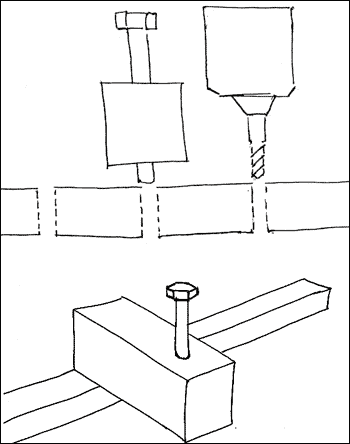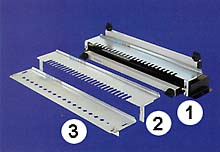Jigs for shelf pin holes
Speeding up the drilling process. March 23, 2002
Q.
I have to drill holes for shelf pins in five bookcases. I am looking for a jig or some type of template to speed up the process.
Forum Responses
1/4 inch thick peg board has holes that are spaced at one inch. A piece of this, cut to size, makes a great short run jig that produces good results. I prefer to use a brad point drill for the holes. Work safe.
There are jigs available for locating and free hand drilling or using on a drill press that are for 5mm boring on 32mm centers. Pretty much the industry standard for case works. %mm shelf pins of several types are readily available. To speed up the process, a line boring machine is quite common.
I use a plunge router with a 1/4" straight bit and a guide bushing. The jig is a 6"x 96" piece of thin plywood with holes (the size of the guide bushing) every inch. Drill the holes on a drill press with a fence for accuracy. Then glue a block on the strip to align it with the top of the cabinet side. Mark start and stop points on the jig and you should be set. Always line the same end of the jig with the same end of the cab parts.
We made our own drilling jigs using the fixture shown below. The fixture uses a block of wood with a 1/4 hole to hold a 1/4 bolt that can drop into the hole drilled by a 1/4 drill bit. The entire fixture clamped to the drill press table. You drill the first hole and slide the jig over until the sliding bolt falls into the hole. Then drill the second hole (and so on). The holes are equally spaced automatically. Wed use a piece of 3/4 hardwood for the actual shelf hole jigs. They held up well but were easily made in batches and discarded when worn. When complete, the jigs were hand-held (or clamped using spring clamps) to the case sides either before or after assembly and the shelf holes drilled using a portable drill.
The hole-to-hole distance is determined by the distance between the block of wood holding the sliding 1/4 bolt and the drill. That flexibility allowed us to vary hole spacing for specialized applications like positioning shelves directly behind mullions in glass doors.
The upper illustration shows the holes being drilled into the shelf hole jig. The lower illustration shows the sliding bolt fixture itself. The fixture should be fastened to a fairly long piece of 3/4 ply to assist when making long jigs.


I use a piece of 1/4 ply 4 1/2 wide with 3/8 diameter holes bored at desired increments 2 inches from edge. I drill holes with a vix type bit that has a 5mm bit and a 3/8 guide. When jig is flipped over, you can drill a partition and not drill into holes on opposite side.
I use the drop pin type jig for drilling sequential holes. However, to prevent the threads on the bolt from tearing the hole edges, I use 1/4 inch bronze rod (also called brazing rod) that I get from a welding supply house. Trying to find brass rod has been very difficult.
Purchase a flat metal ruler, drill hole size using the inch markings, clamp down and use. Cheap to make and easy to use.

